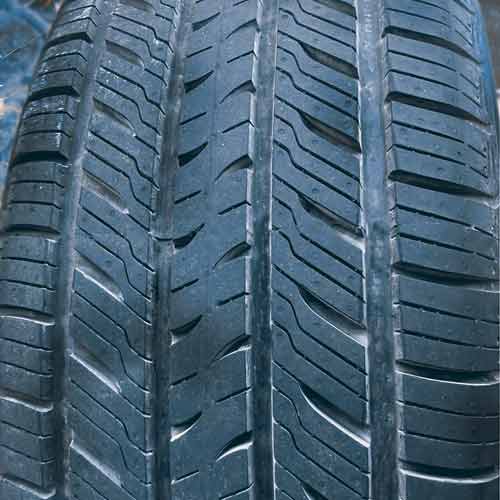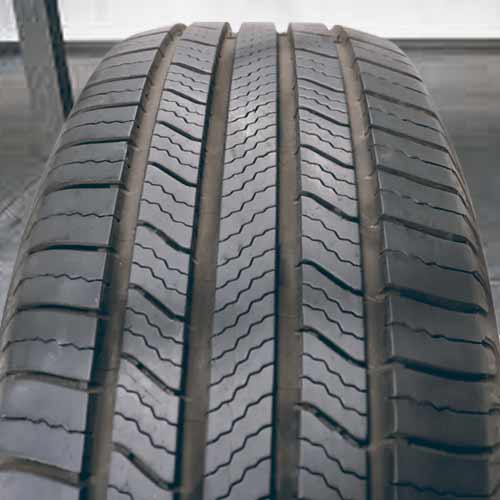The Michelin Defender 2 and Yokohama Avid Ascend LX are both esteemed players in the world of standard touring all-season tires, each offering unique characteristics and performance capabilities. Let’s see how well they perform next to each other.

Table of Contents
Key Takeaway
So overall it all comes down to this. The Defender 2 is better at:
- Dry directional grip and braking effectiveness.
- Handling and steering response in dry conditions.
- Noise reduction, offering a quieter ride at various speeds.
- Wear resistance, thanks to its MAX Touch and EverTread technologies.
Detailed Discussion of Michelin’s Tire: https://tiredriver.com/michelin-defender-2-review/
Whereas the Yokohama Avid Ascend LX has the upper hand in terms of:
- Wet performance, especially in hydroplaning resistance and siping design.
- Impact comfort, with its softer rubber and layered construction.
- Winter performance, offering enhanced traction on soft snow particularly.
Construction
The Yokohama Avid Ascend LX showcases a symmetrical tread pattern, a hallmark of standard touring tires.

Focusing on its three central ribs (or block columns), these form four circumferential grooves along with the shoulders.
Here, the central (most) rib is continuous-running (unbroken), and shows sharp, bidirectional notches and linear sipes for enhanced grip.
While the adjacent ribs, also continuous, are differentiated by their more prominent notches and siping, slanting towards the shoulders.
These shoulder blocks feature significant lateral voids and linear sipes, with rounded outer edges to improve steering responsiveness.
If I talk about the tire’s internal construction, it features a single ply polyester casing with 2 steel belts, and a single ply nylon cap ply. Though its a common feature with the Michelin’s tire.
Speaking of which, the Defender 2, being another standard touring tire, also comes with a symmetric tread pattern. Though its slightly more, you can say, streamlined.

If you compare its shoulder lugs with those of its competitors, you’ll notice how minimalistic they are.
Yet, they are still effective, equipped with a combination of linear and wave-like sipes, and J-shaped outer grooves.
These features enhance wet traction and reduce noise, and I’ll discuss them further in their respective sections.
The central most rib, though continuous like the Ascend LX, is equipped with significantly more sipes.
Similarly, the surrounding lugs feature a similar wave-like siping pattern, and are augmented with lateral voids that link the circumferential grooves together.
This design explains why the tire performs slightly better in clearing water, thereby aiding in hydroplaning resistance. But more on it in the wet performance section.
Sizes Info
The Yokohama Avid Ascend LX comes in 15 to 18 inches wheels, with following specs.
- Speed ratings: T, H and 4 sizes also have V (which is unusual for a standard touring AS tire).
- Load ratings: SL and XL.
- Tread depth: 11/32″ on all.
- Weight range: 18 to 30 lbs.
- Treadwear warranty: 85k miles.
- UTQG rating: 600 to 800 A A.
The Michelin Defender 2 comes in 16 to 20″ inches rims, having following specs.
- Speed ratings: H (on all)
- Load ratings: SL and XL
- Tread depth range: 10.5/32″ (on all)
- Weight range: 25 to 32 lbs
- Tread mileage rating: 85k miles.
- UTQG rating: 800 A A.
Overall Dry Performance
There are three main parts of dry performance, namely directional grip, lateral traction, and steering response. Let’s take a closer look at each of these elements.
Directional Grip
When evaluating directional grip, two key aspects are essential:
- Measurement of grip is primarily gauged through the tire’s braking effectiveness.
- The central tread region plays a crucial role, as this is where the bulk of the weight is distributed when the tire moves straight. This area frequently contacts the road, making it a focal point for traction.
This explains the superior performance of the Michelin tire. Its design features continuous, streamlined central ribs, which increase the rubber-to-road contact area, thereby enhancing longitudinal traction.
In contrast, the Avid Ascend LX falls short for two reasons.
One, the tire’s design includes multiple notches and deep siping slits, which reduce the rubber’s contact area. And two, its heavier construction leads to increased momentum inertia during maneuvers, making it more challenging to halt.
This results in the Yokohama tire having an average braking distance that is 4 feet longer than that of the Defender.
Overall Handling
The cornering grip of a tire is significantly influenced by its shoulder region, on the tread.
Why shoulders? Well because this where majority of tire’s weight shifts, increasing contact with the ground at these points.
Having said that, it makes sense why the Defender 2 comes out with better results here, exhibiting a whole second quicker handling times in lap tests (on average).
The tire features more streamlined outer ribs with fewer tread elements, resulting in increased contact between the shoulders and the road, enhancing grip.
And yes it also features a more responsive steering too, unlike the Yokohama tire.
Basically the main issue with Avid Ascend LX is its heavier and bulkier design, which creates greater inertia during turns. This increased inertia causes the tire lugs to flex more, leading to a slower steering response.
In simpler terms, the lugs of this tire bend more and take longer to return to their original shape compared to those on the Michelin, affecting the overall handling time negatively.
Interesting Read: Improving Dry Performance on All-Season Tires
Wet Performance
On wet roads, a tire’s performance is all about its tread’s ability to expel water, highlighting two significant performance factors: wet traction and the ability to resist hydroplaning. Let’s take a closer look at each factor.
Wet Grip
Achieving optimal wet traction in tires is fundamentally linked to two key elements: extensive siping and the “right level” of tread flexibility.
But why are these elements vital in wet conditions? Let me explain.
So sipes are designed to flex, creating a suction effect that draws water away from the tread, ensuring better contact with the road.
However, this mechanism only works effectively if the tire has enough flexibility; otherwise, the sipes cannot adequately expel moisture.
And this is exactly where Michelin’s performance falls short.
I mean although the tire offers an abundant of full-depth sipes, arranged at various angles they still can’t suck up enough moisture in their slits, because their performance get hampered by its stiffer rubber composition.
Conversely, the Yokohama Avid Ascend LX, while also featuring stiff rubber typical of standard touring tires, actually offers relatively greater pliability here, and so with it, a better siping design.
Though most of its wet performance is still credited to its superior hydroplaning resistance.
Hydroplaning Resistance
Hydroplaning is a phenomenon where a tire loses its grip on the road, due to inadequate water displacement, causing it to effectively “float” or “hydroplane” on a layer of water.
To counteract this, tires are designed with wide grooves that efficiently channel water away from the tread. And in this context, the Avid Ascend LX offers better results.
This is because its design is characterized by a larger void area and deeper tread depth that facilitates superior water dispersal compared to the Defender 2.
And with more water going out this way, there’s less reliance on sipes to begin with. That’s why it makes sense why most of the wet performance of Yokohama’s tire here is attributed to its grooves.
Noise Reduction
Out of both these standard touring tires here, the Defender 2 excels in delivering a quieter ride.
My subjective evaluations tell me that, at lower speeds, the tire emits only a subtle white noise. While on highways, (at higher speeds), although the noise becomes more perceptible, it still blends a lot better with the surrounding ambient sounds compared to Yokohama tire.
Moreover, there’s a distinct interaction between the tire tread and the road surface too which is especially noticeable on ramps, contributing to its overall quieter sound characteristics (as indicated by its decibel readings).
This superior performance of Michelin tire is attributed to its unique J-shaped shoulder and sidewall grooves, both of which basically keep in-groove resonance to a minimum, unlike the louder Avid Ascend LX.
Impact Comfort
When it comes to impact comfort performance, the Yokohama Avid Ascend LX takes the lead.
This is because of its relatively softer rubber and layered construction, which includes an additional polyester layer in its casing and an extra nylon cap ply, enhancing its ability to absorb bumps.
Moreover, the tire’s slightly deeper tread depth further helps with vibration dampening, providing more space (or area of rubber) for bumps to settle down before reaching the vehicle’s cabin.
On the flip side, although the Michelin Defender 2 offers decent stability, it falls short in providing as much cushioning abilities.
This is likely due to its combination of stiffer nylon internal structure and harder rubber composition.
Wear Resistance
Tire tread longevity is influenced by various factors such as tread composition, design, depth, and weight.
And here the Michelin tire takes the upper hand.
The reason lies in its unique technologies, namely the MAX Touch and EverTread. Let me explain.
MAX Touch technology optimizes weight distribution across the tire, reducing rolling resistance. While the EverTread compound, enriched with special polymers, boosts cut resistance, contributing to the tire’s durability further.
This results in the Defender 2 being one of the longest-lasting tires in its category, despite both tires offering the same 85,000-mile treadwear warranty.
For Your Info: I rated the tire best for longevity in my list of top standard touring tires.
Winter Performance
Assessing a tire’s performance in winter conditions requires considering multiple factors, such as its grip, handling, and adaptability to varied terrains.
And in this comparison, while neither the Avid Ascend LX nor its counterpart has the 3 Peak Mountain Snowflake certification, the Yokohama tire still excels in providing enhanced traction, particularly on soft snow.
This superior performance can be attributed to its design elements, which include extensive siping, multi-angled tread patterns, and in-groove notches.
These features facilitate optimal snow-to-snow contact, which is crucial since snow adheres more effectively to itself than to rubber. As a result, this design offers more reliable braking and acceleration.
In contrast, the Michelin Defender 2 falls behind, particularly in terms of lateral traction and steering responsiveness.
And this shortfall is primarily due to its harder compound, which becomes more rigid with colder temperatures, compromising its performance particularly on icy tracks.
Wrapping Up
So, in summary, it’s not a simple task to pick the better tire, considering the unique strengths of each in various categories.
The Defender 2 excels in dry performance due to its superior directional grip and handling. However, in wet conditions, the Avid Ascend LX outperforms it, mainly due to its superior hydroplaning resistance and better siping design.
Yokohama tire also takes the lead in terms of on road comfort, and winter performance. Though lacks to Michelin in terms of tread life and fuel economy and noise reduction performance.